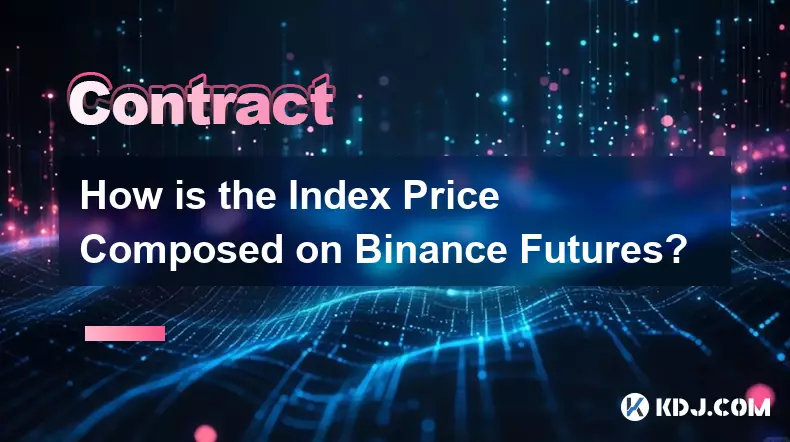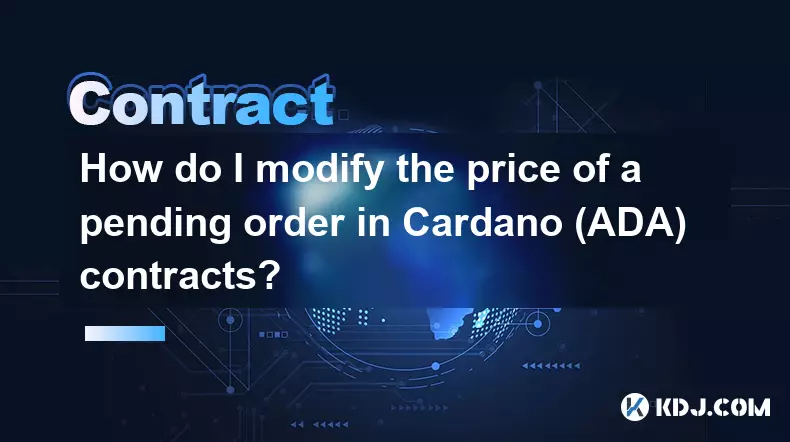-
 bitcoin
bitcoin $109667.069529 USD
-3.03% -
 ethereum
ethereum $3936.685804 USD
-4.07% -
 tether
tether $1.000493 USD
0.01% -
 xrp
xrp $2.771823 USD
-4.74% -
 bnb
bnb $957.805027 USD
-5.34% -
 solana
solana $196.735100 USD
-6.68% -
 usd-coin
usd-coin $0.999727 USD
-0.01% -
 dogecoin
dogecoin $0.227355 USD
-5.12% -
 tron
tron $0.335205 USD
-0.81% -
 cardano
cardano $0.779256 USD
-3.59% -
 ethena-usde
ethena-usde $0.999900 USD
-0.06% -
 hyperliquid
hyperliquid $42.492095 USD
-6.61% -
 chainlink
chainlink $20.501853 USD
-4.34% -
 avalanche
avalanche $28.952606 USD
-11.21% -
 stellar
stellar $0.356038 USD
-3.93%
How is the Index Price Composed on Binance Futures?
Binance Futures uses a multi-exchange index price to ensure fair, transparent, and manipulation-resistant valuations for perpetual contracts.
Sep 25, 2025 at 09:19 am

Understanding the Index Price on Binance Futures
1. The index price on Binance Futures is a critical mechanism designed to prevent manipulation and ensure fair valuation across perpetual contracts. It serves as a benchmark reflecting the broader market value of the underlying asset by aggregating prices from multiple major spot exchanges. This approach minimizes the risk of price distortion due to anomalies or volatility on any single exchange.
2. Binance selects reputable spot exchanges based on criteria such as trading volume, liquidity, and security standards. These exchanges typically include platforms like Coinbase, Kraken, Huobi, and Bitstamp, among others relevant to the specific cryptocurrency. Data from these sources is continuously pulled and weighted to calculate a real-time average.
3. The weighting of each exchange’s price in the index calculation depends on its relative reliability and trading activity. Exchanges with higher volumes and tighter spreads are assigned greater influence. This dynamic adjustment ensures that the index remains representative of genuine market conditions rather than being skewed by less active or potentially unstable platforms.
4. By using an aggregated index instead of relying solely on Binance’s own spot price, the futures market becomes more resilient to short-term price spikes or flash crashes. This structural design supports accurate mark price calculations, which are essential for determining liquidation levels and funding rates.
5. The frequency of index price updates is high, occurring every few seconds. This allows traders to operate with confidence that their positions are monitored against a stable and up-to-date reference point. Transparency in how this data is sourced and processed reinforces trust in Binance’s derivatives ecosystem.
Role of the Index Price in Risk Management
1. One of the primary functions of the index price is to serve as the foundation for calculating the mark price. The mark price is used to determine unrealized profit and loss, as well as to trigger liquidations when margin requirements are breached. Relying on the index helps avoid liquidating positions based on temporary, artificial movements in the contract's last traded price.
2. During periods of extreme volatility, the gap between the contract price and the index price can widen significantly. To mitigate this, Binance applies a smoothing mechanism where the mark price gradually converges toward the index, preventing sudden and unjustified liquidations.
3. Funding rate calculations also incorporate the index price to maintain equilibrium between perpetual contracts and the spot market. When the contract trades at a premium to the index, long positions pay shorts; when it trades at a discount, the reverse occurs. This incentivizes alignment between futures and spot valuations.
4. Traders who engage in arbitrage strategies closely monitor deviations between the contract price and the index. Sustained discrepancies present opportunities to profit while simultaneously contributing to market efficiency by pushing prices back into alignment.
5. The use of the index price enhances overall market integrity by anchoring derivative valuations to real-world spot data across diverse platforms, reducing susceptibility to localized manipulation.
Transparency and Accessibility of Index Data
1. Binance provides public access to index price information through its API and web interface. Traders can view the current index value, constituent exchange prices, and weightings in real time, enabling informed decision-making and custom strategy development.
2. The composition of the index is reviewed periodically, and adjustments are made if an exchange no longer meets the required standards or if new, more reliable platforms emerge. Announcements regarding changes to the index basket are published in advance to maintain transparency.
3. Each cryptocurrency’s index may have a different set of included exchanges depending on regional trading patterns and availability. For example, Bitcoin’s index might include more global exchanges, while a token with strong Asian demand could feature exchanges like Upbit or Bithumb.
4. Historical index data is available for analysis, allowing users to study past correlations between spot and futures markets. This data supports backtesting of trading algorithms and evaluation of market behavior during significant events such as halvings or regulatory announcements.
5. Real-time visibility into the index components empowers traders to verify the accuracy of pricing mechanisms and understand the forces shaping their open positions.
Frequently Asked Questions
What happens if one of the exchanges in the index goes offline?If a participating exchange becomes temporarily unavailable, its weight in the index calculation is reduced or removed until connectivity is restored. Binance monitors these feeds continuously and adjusts the aggregation algorithm to maintain stability and accuracy without disrupting futures pricing.
Can the index price be manipulated by coordinated trades on included exchanges?While theoretically possible, the diversity and size of the selected exchanges make large-scale manipulation extremely difficult and costly. The multi-source averaging model inherently dilutes the impact of abnormal activity on any single platform, making sustained manipulation impractical.
Why doesn’t Binance use only its own spot price for the index?Relying solely on internal spot data would expose the futures market to potential manipulation through wash trading or spoofing. Using a broad index drawn from external, independent exchanges strengthens objectivity and aligns Binance’s pricing with global market consensus.
How often are the weights of exchanges in the index updated?Exchange weights are recalibrated regularly based on evolving trading volume, order book depth, and data reliability. Significant changes are communicated through official channels, though minor adjustments occur automatically within the system to reflect current market dynamics.
Disclaimer:info@kdj.com
The information provided is not trading advice. kdj.com does not assume any responsibility for any investments made based on the information provided in this article. Cryptocurrencies are highly volatile and it is highly recommended that you invest with caution after thorough research!
If you believe that the content used on this website infringes your copyright, please contact us immediately (info@kdj.com) and we will delete it promptly.
- Ruvi AI: The Next Avalanche? Institutional Backing Fuels Presale Frenzy
- 2025-09-27 07:05:16
- Swift, Ethereum, and Layer 2: Bridging Traditional Finance with Blockchain Innovation
- 2025-09-27 06:25:12
- Dubai Fund, TikTok, and US Business: A New Era?
- 2025-09-27 06:45:13
- HBAR Price Bullish Wave: Strong Support Signals Potential Breakout
- 2025-09-27 07:05:16
- Stablecoins, Coinbase, and Investment: Navigating the Future of Finance
- 2025-09-27 07:10:01
- XPL Surge After Launch Crash: From All-Time High to Recovery?
- 2025-09-27 06:45:13
Related knowledge

How do I enable the "scalping-only" mode for Cardano (ADA) contracts?
Sep 24,2025 at 03:19am
Understanding Scalping Strategies in Crypto Derivatives1. Scalping in cryptocurrency trading refers to executing multiple short-term trades within min...

What is the maximum position limit for Cardano (ADA) contracts?
Sep 23,2025 at 11:00pm
Understanding ADA Futures and Derivatives Market Structure1. Cardano (ADA) futures contracts are offered by several major cryptocurrency derivatives e...

What is the maker fee for Cardano (ADA) contracts?
Sep 26,2025 at 09:01am
Understanding Maker Fees in Cardano (ADA) Contracts1. The concept of maker fees applies broadly across decentralized exchanges and smart contract plat...

How can I view open interest in Cardano (ADA) contracts?
Sep 24,2025 at 07:36am
Understanding Open Interest in Cardano Derivatives1. Open interest refers to the total number of outstanding derivative contracts, such as futures or ...

How do I modify the price of a pending order in Cardano (ADA) contracts?
Sep 27,2025 at 01:00am
Understanding Pending Orders in Cardano Smart Contracts1. Cardano operates on a proof-of-stake blockchain that supports smart contracts through its Pl...

What is the function of the insurance fund in Cardano (ADA) contracts?
Sep 24,2025 at 02:18am
Understanding the Role of Insurance Funds in Cardano Smart Contracts1. The insurance fund within Cardano's ecosystem is not a native feature directly ...

How do I enable the "scalping-only" mode for Cardano (ADA) contracts?
Sep 24,2025 at 03:19am
Understanding Scalping Strategies in Crypto Derivatives1. Scalping in cryptocurrency trading refers to executing multiple short-term trades within min...

What is the maximum position limit for Cardano (ADA) contracts?
Sep 23,2025 at 11:00pm
Understanding ADA Futures and Derivatives Market Structure1. Cardano (ADA) futures contracts are offered by several major cryptocurrency derivatives e...

What is the maker fee for Cardano (ADA) contracts?
Sep 26,2025 at 09:01am
Understanding Maker Fees in Cardano (ADA) Contracts1. The concept of maker fees applies broadly across decentralized exchanges and smart contract plat...

How can I view open interest in Cardano (ADA) contracts?
Sep 24,2025 at 07:36am
Understanding Open Interest in Cardano Derivatives1. Open interest refers to the total number of outstanding derivative contracts, such as futures or ...

How do I modify the price of a pending order in Cardano (ADA) contracts?
Sep 27,2025 at 01:00am
Understanding Pending Orders in Cardano Smart Contracts1. Cardano operates on a proof-of-stake blockchain that supports smart contracts through its Pl...

What is the function of the insurance fund in Cardano (ADA) contracts?
Sep 24,2025 at 02:18am
Understanding the Role of Insurance Funds in Cardano Smart Contracts1. The insurance fund within Cardano's ecosystem is not a native feature directly ...
See all articles










































































